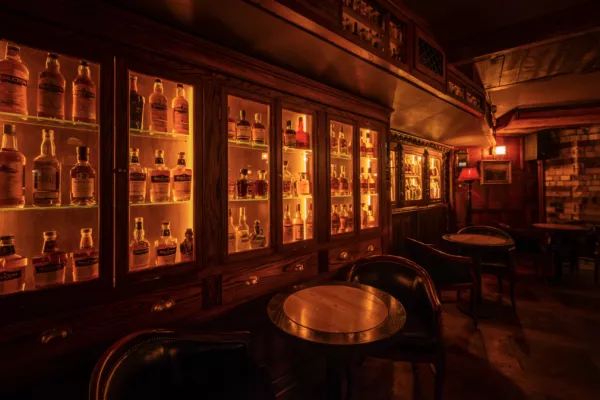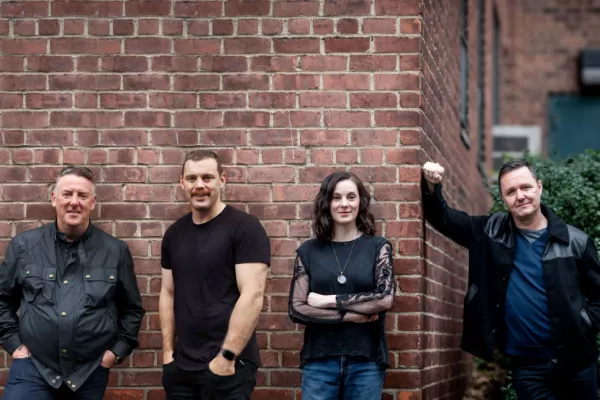Allen Katz is exceptional among New York saloonkeepers in that his bar, the Shanty, operates under a license held by his distillery, New York Distilling Co. in Brooklyn. And he is exceptional among New York home bartenders because his home bar is like a liquid library.
It’s a stately centre of spirituous operations in which happy personal artifacts mingle with bottles speaking seriously to the craft of mixing and the art of living.
The distillery, founded in the neighbourhood of Williamsburg in 2011, now turns out five products—three formidable gins, a 90.4-proof rye whiskey, and Mr. Katz’s Rock & Rye, which is a candy-sweet throwback to the days when characters drank it in John O’Hara novels.
The home bar is on the parlor floor of the townhouse in which Katz lives with his wife and two young daughters in Prospect Heights, Brooklyn. His life story is etched in its glassware. The NFL glasses herald the Baltimore Colts, the home team of his youth; the set from the Trinity College chapter of his fraternity, Saint Anthony Hall, points toward his undergraduate years as a music major; the engraved ones from Chez Panisse hint at his long association with Slow Food USA. It’s that last connection that introduced Katz to his mentors in high-end boozemanship.
“It’s originally from my childhood home in Baltimore,” Katz said of his handsome home-bar infrastructure, a walnut hunk of Kittinger Co. furniture his parents picked up at a northern Virginia flea market in 1972. “The bar was the centerpiece of a small living room in the townhouse we grew up in, and I remember pretty distinctly my father coming home from work every night and having a drink. When my parents moved, I put it in storage. Seven years ago, I got married. Then we moved here two years ago and took the bar out of storage,” he said.
Here, Katz maintains an all-star roster of American whiskey—Parker’s Heritage, Evan Williams Single Barrel, Proprietary Barrel from Wild Turkey, Old Forester Birthday Bourbon, and on and on on. “I don’t think there was a variety like this on my parents’ bar,” Katz supposes. “But they had a pretty interesting variety, for the ’70s.”
The vast array of Pappy van Winkle is intensely impressive. As I admire the scale of my host’s liquor holdings, I wonder aloud what sort of program Katz has for organizing these famously hard-to-find bottles.
“Would you like some? That’s the program. The policy is, if it’s here, you can open it and drink it. ... Pick which one you’d like.” Scrolling through the glass menagerie, he said, “So, here’s a 15-year. Um, let’s see,” as he continued sifting through bottles, whistling while he worked. “That’s the 20 … well, would you like 10? 12? 15? Or the 13-year rye? It’s all nice whiskey.”
Twist my arm—a finger of the 15-year-old Pappy, please. Also: Where is all this whiskey from?
“Many of them are gifts generously given,” he said. “But once in a while, you see something in a store when you’re driving through Maine and you say, ‘Wow! What in the world is this doing here? I need to get that.’”
I asked which bottle he was referring to. “I will find it for you,” Katz said, opening a cabinet door and eventually uncovering the bottle. “I found the Willett Straight Rye, so I picked that up. I’m a rye aficionado. Or a rye freak, if that’s a word.”
I asked if any particular bottle represents the pride of the collection.
“I mean, arrogantly, I am delighted that I have my own rye whiskey,” Katz answered. “But if there’s a pride—even more than the Parker’s, which is fantastic—it’s all the vintages of Evan Williams Single Barrel. It’s a fascinating and delicious whiskey.”
Up on the top shelf is a bottle of Maker’s Mark Mint Julep liqueur, acquired from the distiller some years ago at a horse race.
In my personal experience, the premade Maker’s julep is not a world-class beverage. When I asked Katz to share his opinion of the product, he said, “It’s—it’s absolutely fine. It’s probably better than the julep you’d get at the Kentucky Derby, which has whatever artificial junk they mix the whiskey with for mass production. At the derby, I would much rather take the Maker’s Mark Mint Julep over that.”
At center, in the above photograph, we see a punchbowl destined to serve silken Tom & Jerrys at the winter holidays. “It’s the best damn eggnog you ever had in your life," Katz said. "It’s a recipe preserved, in modern times, by family drinking culture in the upper Midwest. I’m not someone to really purchase anything on EBay, but [the bowl is] sort of a requisite for me.”
Next to the punchbowl, a tiny dancer enlivened a package of Dutch liqueur. She was en pointe.
“This is from my wife’s family," Katz said. "It was in her grandmother's bathroom."
When his wife next entered the room, Katz followed up: “Samantha, what’s the story with the Bols ballerina?”
She said, “It was commemorative from my great-grandparents’ 50th wedding anniversary. It’s a music box. It plays Blue Danube, I believe. Not sure I can still get it to work.”
“This is, very honestly, excess,” Katz said of his bar. “There’s more stuff downstairs, cases of stuff, though I’ve been culling. I have a case of Pikesville rye whiskey sitting in the dining room. That’s what I grew up on. When I learned a Manhattan from my grandmother, it was on Pikesville rye. And there’s now a new Pikesville rye that’s absolutely delicious, and they’re discontinuing the token rye that I grew up on that was primarily preserved for the Maryland market. So I have a case downstairs, because they’re not putting it out anymore. It’s inexpensive as it can be, but it’s as special as anything. ”
I asked Katz to make a drink, and he obliged. It was a Manhattan variation, so he would stir it. The best tool for straining the result into a family-heirloom cocktail coupe would be an inexpensive strainer from a restaurant-supply store on Manhattan's Bowery. Nonetheless, the mixing ritual entailed Katz's sliding out a drawer to retrieve two boxes from la maison Ercuis. One contained a shaker that retails for 590 euros, the other "a very idealized French Hawthorne strainer," Katz said.
“I’m making a variation of a fun cocktail that was known as the Waldorf," he said, swirling chartreuse around the glass. "Traditionally, it’s made with absinthe, and absinthe is lovely, but sometimes it can be a little austere, so I’m using green chartreuse. The sugar [of the chartreuse] is gonna be a little pleasant.”
Waldorf, Chez Katz
Ingredients2 oz. New York Distilling Co. Ragtime Rye3/4 oz. sweet vermouth, preferably Punt e Mes 2 dashes Angostura aromatc bittersA barspoon of green chartreuseLemon
Rinse a chilled cocktail glass with chartreuse and discard the excess. Stir the other liquids well with ice. Strain into the glass. Garnish with a lemon twist and serve.









